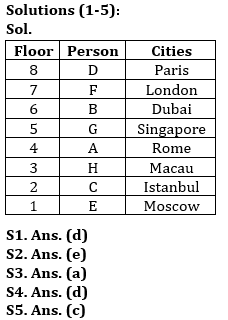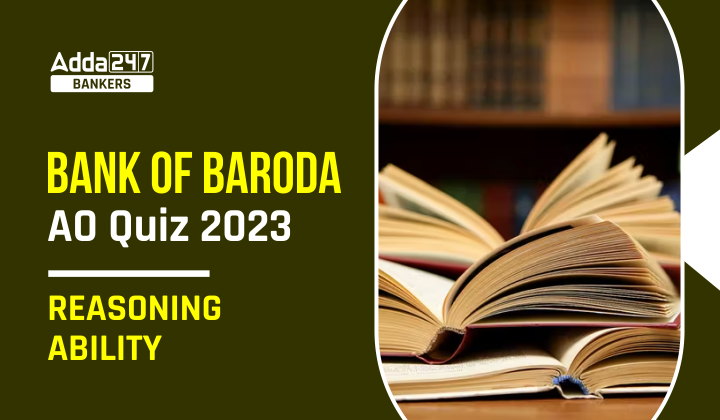Directions (1-5): Study the following information to answer the given questions.
Eight players A, B, C, D, E, F, G and H live on separate floors of an Eight-floor building but not necessarily in the same order. The ground floor is numbered 1, just above floor is numbered 2 and so on till the topmost floor which is numbered as 8. They all like different Cities- London, Rome, Singapore, Macau, Istanbul, Dubai, Moscow and Paris but not necessarily in the same order.
G likes Singapore and lives on an odd numbered floor but above first floor. The one who likes Dubai lives on an even numbered floor above G. Two persons live between the one who likes Dubai and the one who likes Macau. F likes London. Three persons live between H and F who lives above H. F does not live on an even numbered floor. C lives immediately above E. D likes Paris. Three persons live between the one who likes Rome and the one who likes Paris. B lives above A but not on top floor. The one who likes Istanbul lives on an even numbered floor below the one who likes Rome.
Q1. The person who lives on 3rd floor like which of the following City?
(a) Paris
(b) London
(c) Rome
(d) Macau
(e) None of these
Q2. How many persons live between D and the one who likes Istanbul?
(a) None
(b) Four
(c) Three
(d) Two
(e) More than four
Q3. G lives on which floor?
(a) 5th floor
(b) 3rd floor
(c) 7th floor
(d) 1st floor
(e) 4th floor
Q4. Which of the following is true about B?
(a) B likes Moscow
(b) B lives immediate above A
(c) Only two persons live between B and E
(d) The one who likes London lives immediate above B
(e) B lives on 4th floor
Q5. Who lives exactly between F and the one who likes Macau?
(a) A
(b) C
(c) The one who likes Singapore
(d) B
(e) The one who likes Paris
Directions (6-10): In the following questions assuming the given statement to be true, find which of the conclusion(s) among given conclusions is/are definitely true and then give your answers accordingly.
Q6. Statements: A > B ≥ C ≥ D, E = F > G, G = A
Conclusions: I. B = D
II. B > D
(a) Only I is true
(b) Only II is true
(c) Either I or II is true
(d) Neither I nor II is true
(e) Both I and II are true
Q7. Statements: A > B ≥ C ≥ D, E = F > G, G = A
Conclusions: I. G > B
II.C > D
(a) Only I is true
(b) Only II is true
(c) Either I or II is true
(d) Neither I nor II is true
(e) Both I and II are true
Q8. Statements: A > B ≥ C ≥ D, E = F > G, G = A
Conclusions: I. F > A
II.B > F
(a) Only I is true
(b) Only II is true
(c) Either I or II is true
(d) Neither I nor II is true
(e) Both I and II are true
Q9. Statements: A > B > C = D < E < F
Conclusions: I. A > D
II. C < F
(a) Only I is true
(b) Only II is true
(c) Either I or II is true
(d) Neither I nor II is true
(e) Both I and II are true
Q10.Statements: A > B, P > L, L = S
Conclusions: I. B = L
II. L < B
(a) Only I is true
(b) Only II is true
(c) Either I or II is true
(d) Neither I nor II is true
(e) Both I and II are true
Solutions

Solutions (6-10):
S6. Ans. (c)
Sol. I. B = D→ False
II. B > D → False
So, either conclusion I or II is true.
S7. Ans. (a)
Sol. I. G > B→ True
II. C > D → False
Hence, only conclusion I follows.
S8. Ans. (a)
Sol. I. F > A→ True
II. B > F → False
Hence, only conclusion I is true.
S9. Ans. (e)
Sol. I. A > D – True
II. C < F – True
So, both I and II follows.
S10. Ans. (d)
Sol. I. B = L – false
II. L < B – false
There is no specific relation between B and L. So, the statements will be false due to the presence of only two symbols.
Note: If there is no common element between two statements, then the relation of any two unknown elements will be possible only in the presence of all three symbols i.e., ‘<, >, =’





 GA Capsule for SBI Clerk Mains 2025, Dow...
GA Capsule for SBI Clerk Mains 2025, Dow...
 The Hindu Review October 2022: Download ...
The Hindu Review October 2022: Download ...
 World Malaria Day 2025
World Malaria Day 2025




